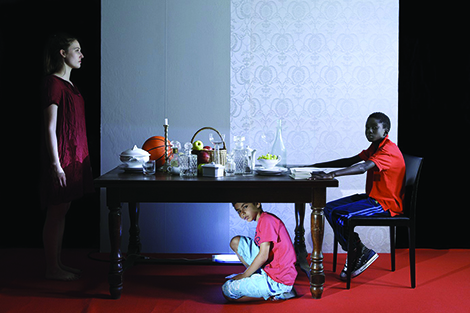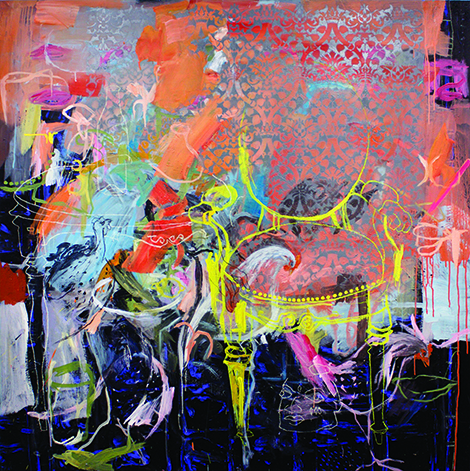It would be negligent to discuss “Guess Who’s Coming to Dinner” at the newly opened Richard Taittinger Gallery without referring to the eponymous film. Both attempt to test and topple our expectations and assumptions. The film’s plot centers on Sidney Poitier’s John Prentice, an exceptional potential husband for the daughter of two West Coast liberals, except for the fact that he’s black. The dinner is an occasion to dramatically uncover the stagnant, inequitable attitudes of the parents (both sets) in order to reason, berate and charm an older generation into accepting the choices of the younger generation if not on entirely new terms (romantic love), at least on terms that previously had not been so boldly proposed to justify the uncommon coupling.
The artists in “Guess Who’s Coming to Dinner,” to quote the exhibition’s curator, Ugochukwu-Smooth C. Nzewi, “have invited themselves to the dinner table of the international mainstream on their own terms.” These terms are not as purveyors of artwork stamped with the African “brand” that is popularly imagined to reflect particular cultural or context-specific values. Rather, these artists critically engage with local circumstances and experiences that join with or invoke transnational and global issues. In short, they insist on being read as part of the burgeoning global contemporary.

Halida Boughriet, Diner des anonymes from the series Pandora, 2014.
Chromogenic color print, 32.6 x 50 in (82.9 x 127 cm).
Because the brand is in its ascendancy, problematizing what Nzewi calls the “burden of African art” is a timely action, and there is mutual advantage for the key actors. Nzewi presents these artists on the crucial New York stage as representative of an internationalism not frequently associated with African artists; consequently the artists benefit from having their work understood within this critical frame, as Nzewi and the gallery acquire the gloss of provocative and insightful dissidence.
The contention “Guess Who’s Coming to Dinner” presents the New York market and the art world is to challenge the nature of their fascination with the African brand. However, the critique of a jaundiced view of cultural aesthetics is not fully apparent in the work itself, but becomes more evident in reading the complicated biographies of these artists whose practices are prisms of a peripatetic Africanness.
For example, Sam Hopkins was born in Italy, grew up between Kenya and England, and now lives in both London, where he is studying for a PhD, and Bayreuth, Germany, where he has a fellowship. Hopkins’ Logos of Non Profit Organizations working in Kenya (some of which are imaginary) (2010 ongoing) is a quite cynical but also playful work that consists of a group of real and imagined NGO logos that purport to indicate the work they do. There is a “tearfund,” a “Safer World,” and one whose logo is a light bulb in the shape of the continent—funny in its pathetic yet condescending attempt at relevance.
Chika Modum was born in Nigeria, attended art school in Calgary, Canada and now lives in Saudi Arabia. In Familiar (2015), she brilliantly renders what appears to be (Caucasian) human skin via digital prints on fabric. The skin is made into a flat background against which some is folded up to form a bow tie concretizing the idea that we make a formal presentation of ourselves with and through our skin. Indeed our skin is our primary clothing.
Gopal Dagnogo’s multi-layered representations of Ivory Coast politics are exceptionally compelling. Born in the Ivory Coast, Dagnogo trained in art in Bordeaux, lived in Burkina Faso, and now resides in Paris. In End of an Era No. 4 (2014), there is a coded but accessible iconography: Louis XVI chairs, toile, live chickens, an African mask, a side table set for drinks. In his work a chaotic swirl of paint marks out objects, but also interrupts them, conflates the foreground and background to capture being caught in a storm in which several realities overlap and impinge on each other.
However, the existing system of aesthetic production and display and the relations it generates conditions this project in particular ways. The entire art world is structured to rarely allow artists to invite themselves, rather, they must wait to be invited. As capital, a key driver of artistic production, finds new markets, developing and exploiting the exotic status of unique brands, benefits accrue to many, but control still tends to pool in one segment. The crucial recalibration of global power both within and outside the art world has yet to occur. We will know it has when African artists and curators are not merely invited, but are regularly creating the occasion to dine.



















fantastic review. love this
“The crucial recalibration of global power both within and outside the art world has yet to occur. We will know it has when African artists and curators are not merely invited, but are regularly creating the occasion to dine.”